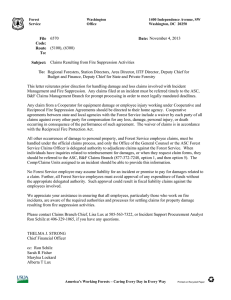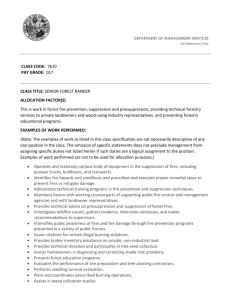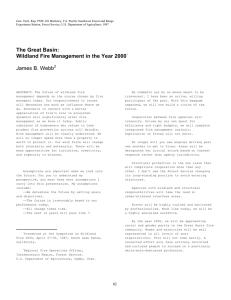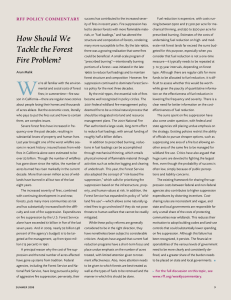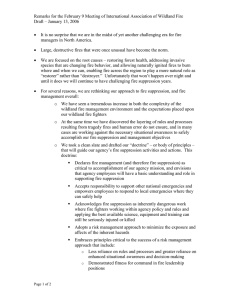Appropriate Suppression Response on the Gila National Forest
advertisement
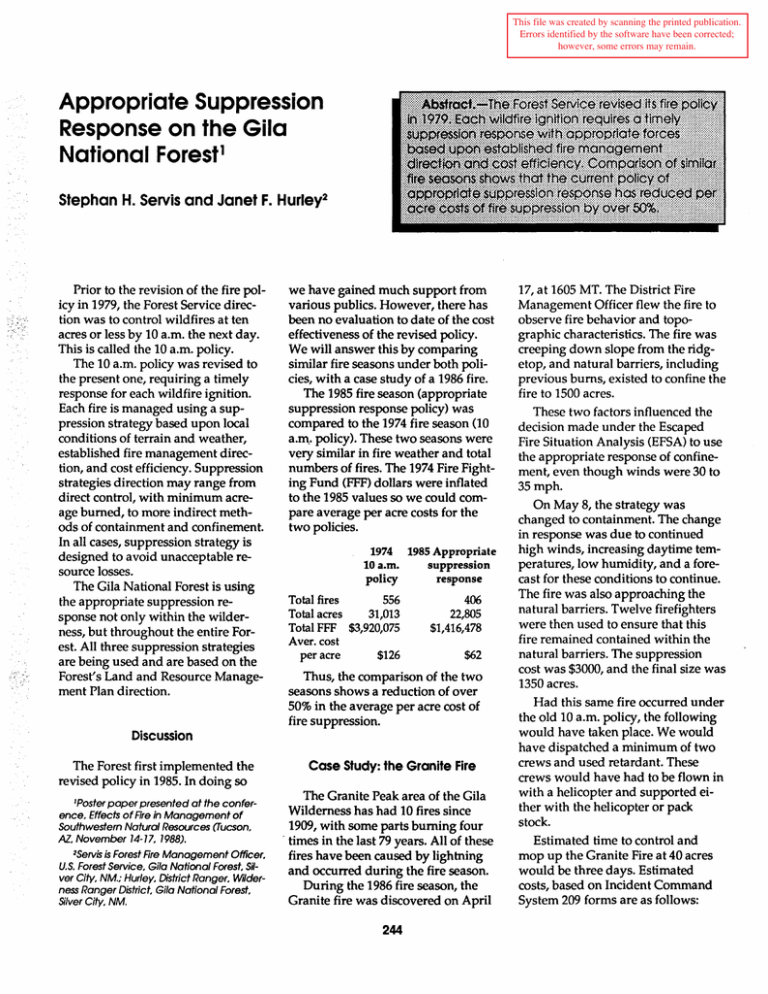
This file was created by scanning the printed publication. Errors identified by the software have been corrected; however, some errors may remain. Appropriate Suppression Response on the Gila National Forest 1 Stephan H. Servis and Janet F. Hurley2 Prior to the revision of the fire policy in 1979, the Forest Service direction was to control wildfires at ten acres or less by 10 a.m. the next day. This is called the 10 a.m. policy. The 10 a.m. policy was revised to the present one, requiring a timely response for each wildfire ignition. Each fire is managed using a suppression strategy based upon local conditions of terrain and weather, established fire management direction, and cost efficiency. Suppression strategies direction may range from direct control, with minimum acreage burned, to more indirect methods of containment and confinement. In all cases, suppression strategy is designed to avoid unacceptable resource losses. The Gila National Forest is using the appropriate suppression response not only within the wilderness, but throughout the entire Forest. All three suppression strategies are being used and are based on the Forest's Land and Resource Management Plan direction. we have gained much support from various publics. However, there has been no evaluation to date of the cost effectiveness of the revised policy. We will answer this by comparing similar fire seasons under both policies, with a case study of a 1986 fire. The 1985 fire season (appropriate suppression response policy) was compared to the 1974 fire season (10 a.m,. policy). These two seasons were v~ry similar in fire weather and total numbers of fires. The 1974 Fire Fighting Fund (FFF) dollars were inflated to the 1985 values so we could compare average per acre costs for the two policies. 1974 1985 Appropriate 10 a.m. suppression response policy Total fires 556 Total acres 31,013 Total FFF $3,920,075 Aver. cost per acre $126 406 22,805 $1,416,478 $62 Thus, the comparison of the two seasons shows a reduction of over 50% in the average per acre cost of fire suppression. Discussion The Forest first implemented the revised policy in 1985. In doing so 1Poster paper presented at the conference. Effects of Rre in Management of Southwestern Natural Resources (Tucson. AZ. November 14-17, 1988). 2Servis is Forest Rre Management Officer, U.S. Forest Service, Gila National Forest, Silver City, NM.: Hurley, District Ranger. Wilderness Ranger District. Gila National Forest. Silver City, NM. Case Study: the Granite Fire The Granite Peak area of the Gila Wilderness has had 10 fires since 1909, with some parts burning four - times in the last 79 years. All of these fires have been caused by lightning and occurred during the fire season. During the 1986 fire season, the Granite fire was discovered on April 244 17, at 1605 MT. The District Fire Management Officer flew the fire to observe fire behavior and topographic characteristics. The fire was creeping down slope from the ridgetop, and natural barriers, including previous bums, existed to confine the fire to 1500 acres. These two factors influenced the decision made under the Escaped Fire Situation Analysis (EFSA) to use the appropriate response of confinement, even though winds were 30 to 35mph. On May 8, the strategy was changed to containment. The change in response was due to continued high winds, increasing daytime temperatures, low humidity, and a forecast for these conditions to continue. The fire was also approaching the natural barriers. Twelve firefighters were then used to ensure that this fire remained contained within the natural barriers. The suppression cost was $3000, and the final size was 1350 acres. Had this same fire occurred under the old 10 a.m. policy, the following would have taken place. We would have dispatched a minimum of two crews and used retardant. These crews would have had to be flown in with a helicopter and supported either with the helicopter or pack stock. Estimated time to control and mop up the Granite Fire at 40 acres would be three days. Estimated costs, based on Incident Command System 209 forms are as follows: Two crews@ 3200/day for 2 days One crew@ 3200/day for 1 day Two airtankers four trips Four loads of retardant @1400/load One lead plane Five helitack crewpersons @$255/day for 3 days (until fire was out) Flight time on Helicopter 308 @$228/hr. for 10 hrs. Total =$6400 = $3200 =$3146 =$5600 =$416 = $3825 =$2280 = $24,867 In this scenario, we would have controlled the fire at 40 acres for a cost of $24,867. The use of appropriate suppression response for this fire realized a saving of $21,867. This is just one of many examples where the ·appropriate suppression response has saved money. Conclusion Review of the last 4 years of appropriate suppression response on the Gila National Forest shows that the policy is cost-effective, while preventing unacceptable resource losses. Implementing this policy when fire behavior can be extreme tested the skills and knowledge of our fire managers. Lightning-caused fires are increasingly allowed to return to their natural role in the wilderness, under the prescribed natural fire program. These past burns, together with the EFSA process, have given our managers the tools to utilize the appropriate suppression response strategies. 245
